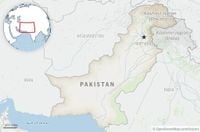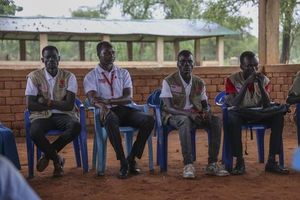In a series of high-stakes operations near the Afghan border, Pakistani security forces have killed 19 militants affiliated with the Pakistani Taliban, marking one of the most significant counterterrorism actions in the region this year. According to statements released by the Pakistani military and reported by multiple news outlets, the raids took place over September 9th and 10th, 2025, targeting three separate militant hideouts in the northwestern province of Khyber Pakhtunkhwa.
The operations, which unfolded in the districts of Mohmand, North Waziristan, and Bannu, were described by the military as part of a broader effort to root out militants who have intensified their attacks in recent months. The militants, referred to as “Khwarij” by the government—a historical term for rebels—are members of Tehreek-e-Taliban Pakistan (TTP), a group that remains separate from but allied with the Afghan Taliban, who seized power in Kabul in 2021. As reported by the Associated Press, Pakistani officials have long accused the TTP of orchestrating a surge of violence in the region, with most recent attacks targeting both security forces and civilians.
The largest confrontation occurred on September 10 in the Guluno region of Mohmand district, where security forces launched an intelligence-based operation that led to an intense firefight. Fourteen militants were killed in this engagement alone, according to the military’s Inter-Service Public Relations (ISPR) office. The following day, two additional operations were carried out: one in Datta Khel, North Waziristan, resulting in the deaths of four militants, and another in Bannu district, where one militant was killed. In total, the operations spanned just over 48 hours and left 19 militants dead.
Weapons and ammunition were recovered from the militants’ hideouts, the ISPR confirmed, emphasizing that those killed had been actively involved in terrorist activities across the region. The military’s statement, cited by AN Pakistan, noted: “On September 9-10, 19 Khwarij members who are members of the Indian Proction, Fitna al Khwarij, were sent to hell in three separate battles in Khyber Pakhtunkhwa Province.” The use of such charged language underscores the intensity of the conflict and the government’s resolve to portray these operations as decisive blows against terrorism.
The backdrop to these operations is a recent uptick in militant violence, particularly from the Pakistani Taliban and Baloch separatist groups in the country’s southwest. Just over a week prior to the raids, on September 2, the TTP carried out a deadly attack on a security camp in Bannu, killing six soldiers. The attack shocked the nation and set off a wave of mourning and calls for action from both the public and the highest levels of government.
Among those who lost their lives in the Bannu attack was Maj. Adnan Aslam, who succumbed to his wounds on September 9 at a military hospital. A video circulating online captured Aslam’s heroic actions during the assault, showing him shielding a wounded soldier before returning fire and killing an attacker, despite being critically injured himself. His bravery has been widely lauded, with Prime Minister Shehbaz Sharif and army chief Field Marshal Asim Munir both attending his funeral earlier this week. As reported by the Associated Press, Aslam has become a symbol of sacrifice and valor for many Pakistanis, with his death serving as a rallying point for renewed efforts against militancy.
The government’s terminology in describing the militants as “Khwarij” is notable. The term, which dates back to early Islamic history, refers to a group that rebelled against established authority and declared other Muslims as infidels. By invoking this label, Pakistani officials are seeking to delegitimize the TTP’s ideology and actions in the eyes of the broader Muslim public. According to AN Pakistan, the military’s report stated: “Weapons and ammunition were also found from India-sponsored dead victims, Khwarij, who are still actively involved in various terrorist activities in these areas.” While accusations of Indian involvement are not new in Pakistani official discourse, New Delhi has consistently denied any links to such groups.
Security forces have indicated that the operations are far from over. The ISPR described ongoing “sanitization operations” aimed at eradicating any remaining militant presence in the affected districts. “The sanitation operation continues to eradicate the remaining militants in these areas, reaffirming that security forces are determined to eradicate militant violence from the country,” the military statement read. This ongoing campaign reflects the Pakistani government’s broader strategy to maintain pressure on militant groups and prevent their resurgence, especially in regions bordering Afghanistan where cross-border movement and support networks remain a challenge.
For residents of Khyber Pakhtunkhwa, these events are all too familiar. The province has long been a flashpoint for militant activity, given its rugged terrain, porous borders, and complex tribal dynamics. The Pakistani Taliban, while distinct from their Afghan counterparts, share ideological roots and have benefited from periods of instability across the border. Since the U.S. withdrawal from Afghanistan in 2021 and the Taliban’s return to power in Kabul, security analysts have warned of a potential spillover effect, with emboldened militants seeking to expand their operations inside Pakistan.
The recent surge in attacks has reignited debates within Pakistan about the best approach to counterterrorism. Some officials and analysts advocate for a hardline military response, arguing that only sustained pressure can break the militants’ operational capabilities. Others caution that without addressing underlying grievances—such as economic marginalization, lack of political representation, and the legacy of past military operations—new waves of militancy could emerge in the future. The government’s dual strategy of forceful action combined with community engagement is, in many ways, an attempt to thread this difficult needle.
Meanwhile, the Pakistani public remains on edge. The memory of past terrorist attacks, including those on schools, markets, and mosques, looms large. The deaths of soldiers and officers like Maj. Adnan Aslam serve as stark reminders of the human cost of the conflict. Yet for many, the latest operations offer a glimmer of hope that the tide may be turning, at least for now.
As the sanitization efforts continue and authorities vow to keep up the pressure, the coming weeks will be a critical test of whether Pakistan’s security forces can sustain their gains and prevent another cycle of violence. What’s clear is that, for the people of Khyber Pakhtunkhwa and beyond, the struggle against militancy remains an urgent and deeply personal battle—one fought not just with weapons, but with resilience and resolve.





